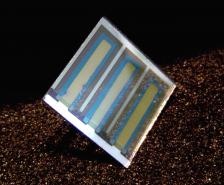May 5 2009
The University of Arizona in Tucson will become the home of a $15 million Energy Frontier Research Center, or EFRC, one of 46 new centers of its kind announced this week.
 An organic photovoltaic cell on glass. The goal for UA scientists is to understand and control the interfaces in these devices at nanometer-length scales (less than 1/100,000 the thickness of a human hair) to enable the development of long-lived solar energy conversion devices on tough, flexible and extremely low-cost plastic substrates. Photo courtesy Neal Armstrong.
An organic photovoltaic cell on glass. The goal for UA scientists is to understand and control the interfaces in these devices at nanometer-length scales (less than 1/100,000 the thickness of a human hair) to enable the development of long-lived solar energy conversion devices on tough, flexible and extremely low-cost plastic substrates. Photo courtesy Neal Armstrong.
At the UA, research could one day lead to "Generation III" photovoltaic materials thin enough, flexible enough and inexpensive enough to go not only on rooftops but in windows, outdoor awnings and even clothing.
The Center for Interface Science: Hybrid Solar-Electric Materials, or CIS:HSEM, was announced by the White House in conjunction with a speech delivered by President Barack Obama on April 27 at the annual meeting of the National Academy of Sciences.
CIS:HSEM is one of two centers in Arizona. Arizona State University's Center for Bio-Inspired Solar Fuel Production is the other, and will collaborate with UA researchers.
The EFRCs, which will pursue advanced scientific research on new forms of solar energy conversion, energy storage, solid-state lighting and related technologies, are being established by the U.S. Department of Energy Office of Science at universities, national laboratories, nonprofit organizations, and private firms across the nation.
CIS:HSEM is specifically one of 16 EFRC's to be funded by President Obama's American Recovery and Reinvestment Act. The 46 EFRCs will each receive funding between $2 and $5 million per year for a planned initial five-year period.
"As global energy demand grows over this century, there is an urgent need to reduce our dependence on fossil fuels and imported oil and curtail greenhouse gas emissions," said Secretary of Energy Steven Chu.
"Meeting this challenge will require significant scientific advances," Chu added. "These Centers will mobilize the enormous talents and skills of our nation's scientific workforce in pursuit of the breakthroughs that are essential to make alternative and renewable energy truly viable as large-scale replacements for fossil fuels."
The centers were selected from a pool of some 260 applications received in response to a solicitation issued by the U.S. Department of Energy Office of Science in 2008. Selection was based on a rigorous merit review process utilizing outside panels composed of scientific experts.
"We look forward to being the lead institution for CIS:HSEM at The University of Arizona, and to working with our partner institutions," said Neal R. Armstrong, director of CIS:HSEM and a UA professor of optical sciences.
"The science of interfaces between different organic and inorganic materials is at the heart of the development of new 'Generation III' photovoltaic technologies. Current photovoltaic technology, such as rooftop collectors, is Generation I," Armstrong said, adding that this should result in an inexpensive and lightweight power source for the future.
"To realize the high efficiencies and low cost such technologies promise will require an unprecedented understanding and control of molecules and molecular composition at nanometer length scales," Armstrong added.
He also said CIS:HSEM was chosen in part because of the unique ensemble of nanometer-scale characterization technologies and interface scientists at the UA.
"CIS:HSEM will foster the scientific research that will enable these new technologies to become reality," Armstrong said.
"The investigators in CIS:HSEM look forward to being a national resource for the study of molecule-based energy conversion systems, and will play a key role in the training of future scientists and leaders in the basic science of solar energy conversion," he added.
The impact of the funding, Armstrong said, is likely to be substanail and immediate in the state of Arizona and that it will be "synergistic" with other forms of funding and also with other organizations and institutes that are already involved in solar initiatives.
EFRC researchers will take advantage of new capabilities in nanotechnology, high-intensity light sources, neutron scattering sources, supercomputing, and other advanced instrumentation, much of it developed with the Department of Energy's Office of Science support over the past decade, in an effort to lay the scientific groundwork for fundamental advances in solar energy, biofuels, transportation, energy efficiency, electricity storage and transmission, clean coal and carbon capture and sequestration, and nuclear energy.
Of the EFRCs selected, 31 are led by universities, 12 by DOE National Laboratories, two by nonprofit organizations, and one by a corporate research laboratory. The criterion for providing an EFRC with Recovery Act funding was job creation. The EFRCs chosen for funding under the Recovery Act provide the most employment for postdoctoral associates, graduate students, undergraduates and technical staff, in keeping with the Recovery Act's objective to preserve and create jobs and promote economic recovery.